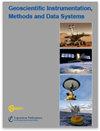使地球科学实验室数据 FAIR:地球物理实验室数据库的概念模型
IF 2.3
4区 地球科学
Q3 GEOSCIENCES, MULTIDISCIPLINARY
Geoscientific Instrumentation Methods and Data Systems
Pub Date : 2024-03-25
DOI:10.5194/gi-13-63-2024
引用次数: 0
摘要
摘要地球科学实验室测量涉及地球科学领域的多种方法。因此,产生的数据分别包括许多不同的数据类型、格式和大小。要处理如此多样的数据,例如将数据存储在一个普遍适用的数据库中,是很困难的。目前已有一些针对特定学科的方法,但至今仍缺乏一个普遍适用于不同地球科学学科的地球科学实验室数据库。不过,向特定社区以外的科学家提供研究数据已变得越来越重要。国际科学理事会数据委员会(CODATA)等全球工作组致力于开发改进研究数据处理的工具。国际标准(如 ISO 19156)和本体论(如 UCUM)为开发数据库模型所需的某些方面提供了总体框架。然而,这些抽象模型需要加以调整,以满足地球科学界的要求。在 NFDI4Earth 计划的一个试点项目中,我们为地球科学实验室数据库开发了一个概念模型。为了能够处理地质科学实验室研究的复杂设置,灵活性和可扩展性是所提出方法的关键属性。该模型旨在遵循 FAIR(可查找性、可访问性、可互操作性和可重用性)数据原则,以促进跨学科应用。在本研究中,我们考虑了现有数据库模型中的不同程序,并将这些方法纳入概念模型。本文章由计算机程序翻译,如有差异,请以英文原文为准。
Making geoscientific lab data FAIR: a conceptual model for a geophysical laboratory database
Abstract. The term of geoscientific laboratory measurements involves a variety of methods in geosciences. Accordingly, the resulting data comprise many different data types, formats, and sizes, respectively. Handling such a diversity of data, e.g. by storing the data in a generally applicable database, is difficult. Some discipline-specific approaches exist, but a geoscientific laboratory database that is generally applicable to different geoscientific disciplines has been lacking up to now. However, making research data available to scientists beyond a particular community has become increasingly important. Global working groups such as the Committee on Data of the International Science Council (CODATA) put effort in the development of tools to improve research data handling. International standards (e.g. ISO 19156) and ontologies (e.g. UCUM) provide a general framework for certain aspects that are elemental for the development of database models. However, these abstract models need to be adapted to meet the requirements of the geoscientific community. Within a pilot project of the NFDI4Earth initiative, we developed a conceptual model for a geoscientific laboratory database. To be able to handle the complex settings of geoscientific laboratory studies, flexibility and extensibility are key attributes of the presented approach. The model is intended to follow the FAIR (findability, accessibility, interoperability, and reusability) data principles to facilitate interdisciplinary applicability. In this study, we consider different procedures from existing database models and include these methods in the conceptual model.
求助全文
通过发布文献求助,成功后即可免费获取论文全文。
去求助
来源期刊

Geoscientific Instrumentation Methods and Data Systems
GEOSCIENCES, MULTIDISCIPLINARYMETEOROLOGY-METEOROLOGY & ATMOSPHERIC SCIENCES
CiteScore
3.70
自引率
0.00%
发文量
23
审稿时长
37 weeks
期刊介绍:
Geoscientific Instrumentation, Methods and Data Systems (GI) is an open-access interdisciplinary electronic journal for swift publication of original articles and short communications in the area of geoscientific instruments. It covers three main areas: (i) atmospheric and geospace sciences, (ii) earth science, and (iii) ocean science. A unique feature of the journal is the emphasis on synergy between science and technology that facilitates advances in GI. These advances include but are not limited to the following:
concepts, design, and description of instrumentation and data systems;
retrieval techniques of scientific products from measurements;
calibration and data quality assessment;
uncertainty in measurements;
newly developed and planned research platforms and community instrumentation capabilities;
major national and international field campaigns and observational research programs;
new observational strategies to address societal needs in areas such as monitoring climate change and preventing natural disasters;
networking of instruments for enhancing high temporal and spatial resolution of observations.
GI has an innovative two-stage publication process involving the scientific discussion forum Geoscientific Instrumentation, Methods and Data Systems Discussions (GID), which has been designed to do the following:
foster scientific discussion;
maximize the effectiveness and transparency of scientific quality assurance;
enable rapid publication;
make scientific publications freely accessible.
 求助内容:
求助内容: 应助结果提醒方式:
应助结果提醒方式:


